Link consigliati:
Tra la Carolina del Nord e il Virginia sorge un luogo misterioso rimasto inesplorato per secoli: la Grande Palude Lugubre, dove pare che comunità di schiavi africani fuggiaschi si siano rifugiate e adattate per sfuggire alla dura schiavitù imposta dai colonizzatori.
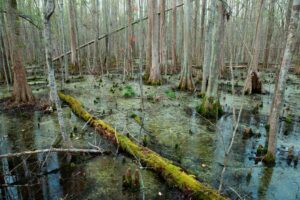 Aspetto della palude tra passato e futuro
Aspetto della palude tra passato e futuro
James Town, il primo insediamento inglese stabile nel nuovo continente, fu fondata nel 1607 a soli 70 km dalla palude; all’epoca il territorio di quest’ultima si estendeva per 4046 km² ed era abitata da molti animali tra cui insetti e serpenti pericolosi. Nel 1763 George Washington fondò la Dismal Swamp Company con l’obiettivo di prosciugare la palude, abbattere gli alberi e rendere il territorio adatto alla coltivazione: questo ha dato il via a una serie di trasformazioni negli anni successivi, tanto che oggi la palude corrisponde solo a un ottavo della sua precedente estensione. A causa dei problemi legati soprattutto al surriscaldamento globale, come gli incendi che possono divampare facilmente in un territorio del genere, è stata dichiarata area naturale protetta e si sta lavorando a un sistema per reidratare la palude, rendendola meno pericolosa per i centri abitati circostanti.
Ricerche svolte
Chi potrebbe essersi mai stabilito in un luogo tanto inospitale e pericoloso, dove le superfici asciutte scarseggiano e gli animali possono ucciderti da un momento all’altro? A noi l’idea sembra quasi assurda, eppure si ipotizza che dei gruppi di schiavi africani, presenti sul territorio di James Town dal 1619, abbiano trovato rifugio nella Grande Palude Lugubre per sfuggire al duro lavoro nelle piantagioni. Gli storici sono divisi da due ipotesi principali: la prima è che la palude sia stata solo un passaggio per raggiungere luoghi più sicuri nel Nord del paese, mentre la seconda è che i fuggitivi abbiano trovato una zona asciutta e sicura abbastanza da creare delle vere e proprie comunità e restare a lungo. Daniel Sayers, archeologo storico e capo del dipartimento di antropologia dell’American University, propende di più per la seconda opzione, e nel 2003 ha inaugurato un programma di ricerca chiamato The Great Dismal Swamp Landscape Study per provare la possibilità della vita nella palude; è il primo ad averlo fatto. Anche se non sono ancora stati trovati dei resti umani, qualcosa di interessante è già stato rinvenuto.
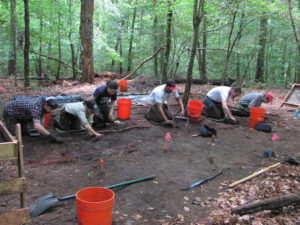 Nell’immagine possiamo vedere una squadra di archeologi al lavoro nella palude, dove Sayers ha scavato trovando delle tracce nel terreno sottostante; qui doveva trovarsi una capanna in legno nel 1680 circa. Naturalmente non era sola, perché solo su quest’isola lo 0,4% del territorio presenta segni simili, come macchie scure e a volte addirittura frammenti di oggetti; sono stati ritrovati per esempio: un frammento di argilla bianca, che un tempo doveva far parte di una pipa per tabacco, un’unghia, un pezzo di piombo, un coccio di vetro e un chiodo non del tutto integro. In questo territorio degli schiavi fuggiaschi potrebbero aver fondato una sorta di città, piccola ma assolutamente non insignificante, dove riuscirono a vivere in pace solo tra di loro. Per indicare questo tipo di comunità si utilizza il termine Cimarroni, che sono dei veri e propri gruppi ribelli nati dai primi Afroamericani; il nome è molto generico, tant’è che si possono trovare comunità di Cimarroni nella storia di Cuba, della Giamaica, del Brasile, e così in molti altri stati del continente americano. Sayers stima che i fuggiaschi vissuti nella Grande Palude Lugubre potrebbero essere stati 100 mila, alcuni di loro magari non videro mai un bianco in vita loro.
Nell’immagine possiamo vedere una squadra di archeologi al lavoro nella palude, dove Sayers ha scavato trovando delle tracce nel terreno sottostante; qui doveva trovarsi una capanna in legno nel 1680 circa. Naturalmente non era sola, perché solo su quest’isola lo 0,4% del territorio presenta segni simili, come macchie scure e a volte addirittura frammenti di oggetti; sono stati ritrovati per esempio: un frammento di argilla bianca, che un tempo doveva far parte di una pipa per tabacco, un’unghia, un pezzo di piombo, un coccio di vetro e un chiodo non del tutto integro. In questo territorio degli schiavi fuggiaschi potrebbero aver fondato una sorta di città, piccola ma assolutamente non insignificante, dove riuscirono a vivere in pace solo tra di loro. Per indicare questo tipo di comunità si utilizza il termine Cimarroni, che sono dei veri e propri gruppi ribelli nati dai primi Afroamericani; il nome è molto generico, tant’è che si possono trovare comunità di Cimarroni nella storia di Cuba, della Giamaica, del Brasile, e così in molti altri stati del continente americano. Sayers stima che i fuggiaschi vissuti nella Grande Palude Lugubre potrebbero essere stati 100 mila, alcuni di loro magari non videro mai un bianco in vita loro.
Luminescenza otticamente stimolata (OSL)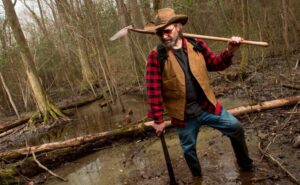
Si tratta di una tecnica impiegata nella datazione di oggetti e sostanze esposte al calore; Sayers se ne è servito per datare il terreno su cui sorgeva la prima capanna rinvenuta. Viene sfruttato un raggio di fotoni che investe il campione, il quale è stato in qualche modo esposto a una forma di calore come il fuoco o il sole: per questo motivo la luminescenza otticamente stimolata è particolarmente efficace quando si analizzano, per esempio, oggetti in ceramica o pareti di forni. Può funzionare anche per la sabbia calcolandone l’ultima esposizione al sole, come in questo caso. Spesso la OSL viene scartata perché gli archeologi si limitano a studiare la manifattura dei reperti per datarli, ma chiaramente non si potrebbe fare lo stesso in questo caso, visto che gli abitanti della palude erano determinati a non avere alcun contatto con il mondo esterno e impiegavano soprattutto materiali biodegradabili già presenti sul territorio.
La peculiare istituzione
Per capire cosa può aver spinto delle persone a rischiare di vivere in un ambiente tanto ostile dobbiamo prima di tutto considerare che vita facessero gli schiavi africani in quegli anni. La tratta di schiavi, chiamata istituzione peculiare dagli schiavisti, ha reso gli stati del sud come la Louisiana, la Virginia, la Carolina del Nord e del Sud delle potenze industriali grazie alla coltivazione di cotone, tabacco, zucchero e caffè. Le condizioni in cui gli schiavi vivevano erano durissime sin dal viaggio che intraprendevano per arrivare in America, spesso importati dai portoghesi, e una volta venduti a dei padroni locali la loro vita poteva essere sfruttata in qualsiasi modo. La fustigazione era una delle punizioni più comuni, ma si poteva anche essere lasciati per alcuni giorni in una fossa nel terreno; alcuni padroni uccidevano i loro schiavi in caso di disubbidienza. È chiaro che non mancarono le ribellioni, principalmente di due tipi: fuggire per mettersi al sicuro in luoghi inesplorati, come fecero i Cimarroni, e la violenza verso i padroni.. Una delle rivolte più conosciute avvenute in Virginia è quella della Contea di Southampton guidata da Nat Turner, famoso come lo “schiavo predicatore”, in quanto affermava di aver agito poiché ispirato da Dio: a partire dalla notte del 21 Agosto 1831 Nat e i suoi uccisero tra i 55 e i 60 bianchi, tra cui molti bambini, ed esortarono i loro schiavi ad unirsi, ma le milizie intervennero presto fermando definitivamente l’insurrezione il 23. I ribelli furono arrestati e uccisi; molti schiavi morirono nei giorni seguenti, anche chi non aveva preso parte alla rivolta o si era addirittura opposto.
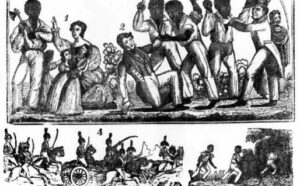
Nat Turner riuscì a mettersi in salvo per i successivi due mesi e in molti ipotizzarono che avesse trovato rifugio nella Grande Palude Lugubre, che si trovava nei pressi di Southampton, e stesse provando a farne uscire gli abitanti per ribellarsi. Non era infatti completamente ignoto che degli ex schiavi vivessero lì, ma nessuno ebbe mai davvero il coraggio di andare alla loro ricerca. Quando fu trovato non lontano dalla piantagione in cui lavorava Turner confessò senza esitazione; venne impiccato e il suo corpo fu fatto a pezzi come ammonimento per chiunque volesse opporsi alla schiavitù: si dice che la sua amante abbia ricevuto una borsa fatta con la sua pelle.
Scegliere la vita nella palude per evitare di continuare a vivere come schiavi fu un atto di ribellione immenso. Avere un’opportunità per vivere in libertà, anche se in un ambiente ostile, è stata la speranza di molte persone, le cui vite hanno avuto un’importanza enorme per la storia degli Stati Uniti.
THE GREAT DISMAL SWAMP
Between the states of Virginia and North Carolina there is a mysterious place named “the Great
Dismal Swamp”, which had never truly been explored for many years. It seems like communities of
runaway African slaves estabilished there to avoid the harsh slavery imposed by the settlers.
The Swamp’s appearance through the years
James Town, the very first stable English settlement in America, was founded in 1607 about 70 km
far from the Swamp; back then the Swamp’s area was 4046 km² large and many animals lived
there, including dangerous insects and snakes. In 1763 George Washington founded the Dismal
Swamp Company in order to drain the swamp, cut the trees down and make a cultivated land out of
it. The Company led off a bunch of transformations in the next few years to the point that today the
Swamp is only an eighth of its original size. Because of a lot of problems, especially caused by
global warming like the fires that can easily blaze in such a territory, they declared it a protected
area. Today local organizations are working to rehydrate the swamp in order to avoid fires and
prevent trees to fall down. These measures are supposed to make the Swamp less dangerous for the
nearby residential areas.
Researches
Who could have lived in such an inhospitable and harsh place, where dry surfaces are insufficient
and animals would try to kill you all the time? We might think that this is a terrible idea, but some
people suppose that groups of African slaves, who were living in James Town’s area since 1619,
found a safe shelter in the Great Dismal Swamp to avoid working in plantations. Because of their
different opinions, historians can be divided into two groups: the first one believes that the fugitives
came across the Swamp while trying to reach safer refuges in the North; the second possibility is
that they found a zone dry enough to create a small town and stay there for a long time.
Daniel Sayers, archaeologist and head of the archaeology’s department at the American University,
belongs in the second group and is the first one to conduct a research into the Swamp to prove that,
even there, life was possible. Although no human rest has been found yet, something interesting
was rediscovered already.
By digging on an island, Sayers found the trails of a wooden shed from 1680. It wasn’t even the
only one, because the 0,4% of that island has similar trails like dark stains and even objects’
fragments. Sayers rediscovered a scrap of white clay, which used to be a pipe, a nail, a piece of
lead, another one of glass and a broken spike, for example. Some fugitives might have built a sort of
town in this area, a small one for sure, where they could live peacefully on their own. We use the
term “Maroons” to talk about those communities of rebellious African slaves; it’s a very general
name, there were Maroons in Brazil, Cuba and Jamaica, as well as many other countries in
America.
Sayers believes that about a hundred thousand fugitives have lived in the Great Dismal Swamp,
some of them probably never saw a white man.
Optically stimulated luminescence
This is a procedure that allows archaeologists to date their discoveries; Sayers have used it too. It
works with objects that were exposed to the heat or to the sunlight, for example sand, by calculating
when it was exposed to the heat for the last time. Usually historians can simply study the objects’
manufacture and date them thanks to their knowledge, but clearly this is not possible in the Swamp,
since its inhabitants didn’t want any contact with the rest of the world and were mainly using local
biodegradable materials.
The Peculiar Institution
But how were the slaves living at that time? This is very important to understand why some of them
risked everything to escape. The slave trade, also called peculiar institution, is the reason why
southern states such as Louisiana, Virginia, North and South Carolina became so important and
powerful; so many slaves were working in cotton, tobacco, sugar and coffee’s plantations and living
in very poor conditions since they started their travel towards America. Once they were sold to a
local owner, their lives were in the whites’ hands. Whipping was one of the most common forms of
punishment, but some masters were more violent and could even kill their slaves.
Some of them decided to rise up of course, they could either run away, like the Maroons did, or use
violence towards their owners. A very famous rebellion is the Southampton Insurrection, which
happened in Virginia was led by Nat Turner, an African slave known as “the Prophet”, since he said
he got inspired by God.. On August 21 1831, at night, Nat and other slaves started a carnage killing
about 55 or 60 white people, including a lot of children, in just three days. On the 23 rd the militias
stopped the insurrection; not only the rebels were arrested and killed, but a lot of innocent slaves
were murdered by their masters too because of the Insurrection. Nat Turner escaped and managed to
hide himself for two months; many people thought that he was in the Great Dismal Swamp, not far
from Southampton, and was trying to convince the fugitives to go out and rebel. He was then
arrested next to the plantation where he used to work, he confessed everything and got hanged. It is
said that Turner’s body was mutilated and his lover received a bag made by his skin.
Choosing to live in the Swamp was such a great act of rebellion. For those people that was the only
possibility to obtain freedom, even if in challenging conditions and the only hope left. This is very
important for the history of the United States of America and should never be forgotten.
ARTICOLO REDATTO DA ELISA MAFFEO DELLA CLASSE IIIA DEL LICEO CLASSICO
SITOGRAFIA:
Rai Play, Passaggio a Nord Ovest: Le origini romane di Assisi e la Great Dismal Swamp
http://http://www.storiain.net/storia/la-schiavitu-in-america-una-peculiare-istituzione/
http://https://www.appuntidistoria.net/luminescenza-otticamente-stimolata-osl/
http://https://www.archaeologicalconservancy.org/great-dismal-swamp/
BIBLIOGRAFIA:
“Dred: A Tale of the Great Dismal Swamp” – Harriet Beecher Stowe
“Narrative of the Life of Moses Grandy, Late a Slave in the United States of America” – Moses Grandy

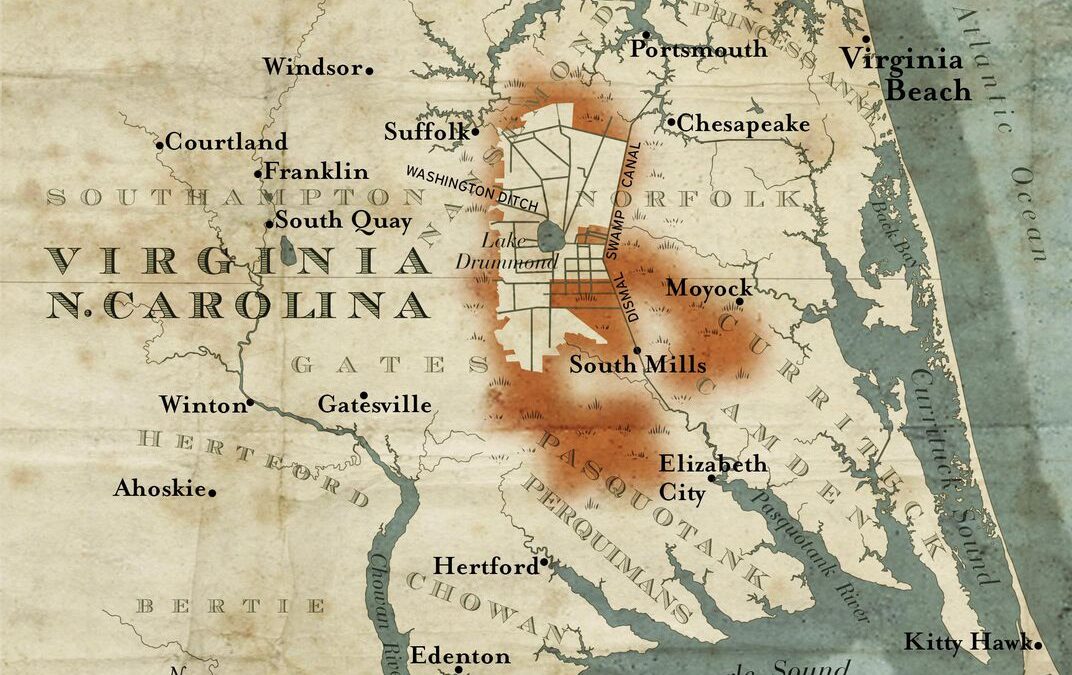
Commenti recenti